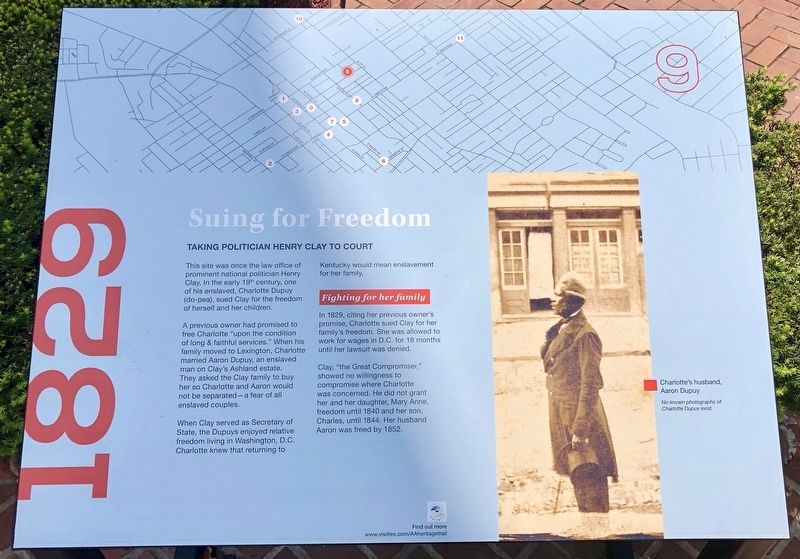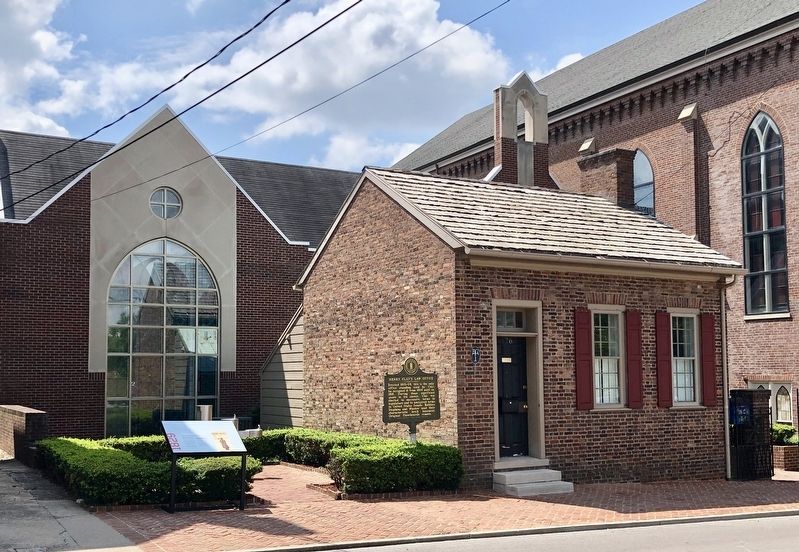Gratz Park in Lexington in Fayette County, Kentucky — The American South (East South Central)
Taking Politician Henry Clay to Court 1829
Suing for Freedom
— Downtown African-American Heritage Trail —
A previous owner had promised to free Charlotte "upon the condition of long & faithful services." When his family moved to Lexington, Charlotte married Aaron Dupuy, an enslaved man on Clay's Ashland estate. They asked the Clay family to buy her so Charlotte and Aaron would not be separated-a fear of all enslaved couples.
When Clay served as Secretary of State, the Dupuys enjoyed relative freedom living in Washington, D.C. Charlotte knew that returning to Kentucky would mean enslavement for her family.
Fighting for her family
In 1829, citing her previous owner's promise, Charlotte sued Clay for her family's freedom. She was allowed to work for wages in D.C. for 18 months until her lawsuit was denied Clay, "the Great Compromiser," showed no willingness to compromise where Charlotte was concerned. He did not grant her and her daughter, Mary Anne, freedom until 1840 and her son, Charles, until 1844. Her husband Aaron was freed by 1852.
Erected 2018 by Together Lexington. (Marker Number 9.)
Topics. This historical marker is listed in these topic lists: African Americans • Civil Rights • Women. A significant historical year for this entry is 1829.
Location. 38° 2.975′ N, 84° 29.804′ W. Marker is in Lexington, Kentucky, in Fayette County. It is in Gratz Park. Marker is on North Mill Street north of Church Street, on the right when traveling north. Touch for map. Marker is at or near this postal address: 176 North Mill Street, Lexington KY 40507, United States of America. Touch for directions.
Other nearby markers. At least 8 other markers are within walking distance of this marker. Henry Clay's Law Office (here, next to this marker); First Presbyterian Church (within shouting distance of this marker); Lexington Public Library 1905 - 1989 / A Carnegie Library (within shouting distance of this marker); Morgan House (within shouting distance of this marker); Samuel Brown, M.D. (1769 - 1830) (within shouting distance of this marker); Christ Church Cathedral (within shouting distance of this marker); Hunt-Morgan House (about 300 feet away, measured in a direct line); Thomas Hunt Morgan / Genetic Research (about 500 feet away). Touch for a list and map of all markers in Lexington.
Regarding Taking Politician Henry Clay to Court 1829.
Slavery (1782-1865)
Lexington’s early success was built upon the enslavement of its residents. Those who did not directly profit from the enforcement of slavery indirectly supported those who owned, jailed, captured, bred, or sold Lexington’s African-American residents. In 1860, a little under half (45%) of Lexington’s population were enslaved. Of the total African-American men and women within the city, six percent were free. These subjugated individuals did not passively accept their station; they fought to define their independence through religious institutions, business networks, and legal systems.
Related marker. Click here for another marker that is related to this marker.
Credits. This page was last revised on February 12, 2023. It was originally submitted on July 22, 2019, by Mark Hilton of Montgomery, Alabama. This page has been viewed 198 times since then and 10 times this year. Photos: 1, 2. submitted on July 22, 2019, by Mark Hilton of Montgomery, Alabama.

